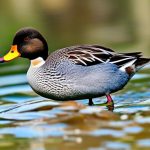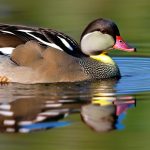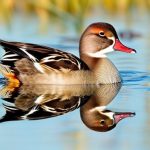Ducks have been domesticated for thousands of years, with evidence of their presence dating back to ancient Egypt and China. These birds were initially kept for their meat, eggs, and feathers, but over time, different breeds were developed to suit specific purposes. Today, duck breeds play a crucial role in agriculture and conservation efforts.
The domestication of ducks began around 4,000 years ago in Asia, where they were primarily raised for their eggs and meat. Ducks were also valued for their feathers, which were used for insulation and as a filling for pillows and mattresses. As trade routes expanded, ducks were introduced to other parts of the world, including Europe and the Americas.
In agriculture, duck breeds are important for their ability to provide a sustainable source of meat and eggs. They are known for their efficient feed conversion rates, meaning they can convert feed into meat or eggs more efficiently than other poultry species. Additionally, ducks are excellent foragers and can help control pests in agricultural fields.
In terms of conservation, duck breeds play a vital role in preserving genetic diversity. Many duck breeds are at risk of extinction due to habitat loss, pollution, and the introduction of non-native species. By conserving these breeds, we can ensure the survival of unique genetic traits that may be valuable in the future.
Key Takeaways
- There are many different breeds of ducks, each with their own unique characteristics and uses.
- The most popular duck breeds worldwide include the Pekin, Muscovy, and Mallard.
- Domestic duck breeds are often raised for meat, eggs, or as pets, and include the Khaki Campbell and Rouen.
- Rare and endangered duck breeds, such as the Silver Appleyard and Aylesbury, require conservation efforts to prevent extinction.
- Waterfowl breeds, such as the American Black Duck and Wood Duck, are popular for hunting and conservation efforts.
The Most Popular Duck Breeds Worldwide
1. Pekin Duck: The Pekin duck is one of the most popular duck breeds worldwide. Originating from China, it is known for its large size and white plumage. Pekin ducks are primarily raised for meat production due to their fast growth rate and high meat yield. They are also commonly used in crossbreeding programs to improve the meat quality of other duck breeds.
2. Muscovy Duck: The Muscovy duck is another popular breed known for its unique appearance and lean meat. Unlike other duck breeds, Muscovy ducks are not as reliant on water and can thrive in a variety of environments. They are often raised for their meat, which is considered leaner and more flavorful than other duck meats.
3. Khaki Campbell Duck: The Khaki Campbell duck is a British breed that is highly regarded for its egg-laying abilities. These ducks are known to lay a large number of eggs, often surpassing even the most productive chicken breeds. They are also popular for their calm temperament and adaptability to different climates.
4. Indian Runner Duck: The Indian Runner duck is a breed that originated in Southeast Asia and is known for its distinctive upright posture. These ducks are primarily kept for their egg-laying abilities, with some individuals capable of laying up to 300 eggs per year. Indian Runner ducks are also popular for their comical appearance and are often kept as pets or for exhibition purposes.
5. Rouen Duck: The Rouen duck is a breed that originated in France and is closely related to the Mallard duck. It is known for its large size and beautiful plumage, which resembles that of the Mallard. Rouen ducks are primarily raised for meat production, but they are also popular as ornamental birds due to their striking appearance.
An Overview of Domestic Duck Breeds
Domestic ducks differ from their wild counterparts in several ways. Domestic ducks have been selectively bred for specific traits such as meat production, egg-laying ability, or ornamental purposes. They also tend to have larger bodies and less flight capability compared to wild ducks.
There are many different domestic duck breeds, each with its own unique characteristics and uses. Some common domestic duck breeds include the Pekin, Muscovy, Khaki Campbell, Indian Runner, and Rouen ducks.
The Pekin duck, as mentioned earlier, is primarily raised for meat production due to its fast growth rate and high meat yield. It is a large breed with white plumage and a calm temperament, making it easy to handle and manage.
Muscovy ducks, on the other hand, are known for their lean meat and adaptability to different environments. They are often raised for meat production but can also be kept for their eggs or as ornamental birds. Muscovy ducks have unique features such as caruncles (fleshy growths) on their faces and claws on their feet.
Khaki Campbell ducks are highly regarded for their egg-laying abilities. They are known to lay a large number of eggs, often surpassing even the most productive chicken breeds. Khaki Campbell ducks are also popular for their calm temperament and adaptability to different climates.
Indian Runner ducks are primarily kept for their egg-laying abilities. They have a distinctive upright posture and are known to lay a large number of eggs per year. Indian Runner ducks are also popular as pets or for exhibition purposes due to their comical appearance.
Rouen ducks, originating from France, are closely related to the Mallard duck. They are known for their large size and beautiful plumage, which resembles that of the Mallard. Rouen ducks are primarily raised for meat production but are also popular as ornamental birds due to their striking appearance.
Rare and Endangered Duck Breeds
Some duck breeds are considered rare or endangered due to various factors such as habitat loss, pollution, and the introduction of non-native species. These breeds often have unique genetic traits that make them valuable for conservation efforts.
One example of a rare duck breed is the Hook Bill duck. This breed is known for its distinctive hooked bill and is believed to have originated in the Netherlands. Hook Bill ducks are at risk of extinction due to their small population size and limited distribution.
Another rare duck breed is the Silver Appleyard duck. This breed was developed in England in the mid-20th century and is known for its beautiful plumage and good meat quality. Silver Appleyard ducks are considered rare due to their declining population numbers.
Conservation efforts are crucial for preserving rare and endangered duck breeds. These efforts often involve breeding programs, habitat restoration, and public education. By conserving these breeds, we can ensure the survival of unique genetic traits that may be valuable in the future.
Waterfowl Breeds: Ducks for Hunting and Conservation
Waterfowl duck breeds are specifically bred for hunting and conservation purposes. These breeds are often used in wetland management programs to control populations of invasive species and maintain the ecological balance of wetland habitats.
One popular waterfowl duck breed is the Mallard duck. Mallards are native to North America and are known for their adaptability to different environments. They are often hunted for sport and their meat, but they also play a crucial role in wetland conservation.
Another waterfowl duck breed is the Wood Duck. Wood Ducks are known for their vibrant plumage and unique nesting habits. They are often hunted for sport but are also valued for their aesthetic appeal and contribution to wetland ecosystems.
The Canvasback duck is another waterfowl breed that is highly regarded by hunters. Canvasbacks are known for their fast flight speed and excellent diving abilities, making them a challenging target for hunters. They are also valued for their meat, which is considered one of the best-tasting among duck species.
Waterfowl duck breeds play a vital role in maintaining the ecological balance of wetland habitats. By controlling populations of invasive species, these breeds help preserve the biodiversity of wetland ecosystems and ensure the survival of native flora and fauna.
Ornamental Duck Breeds: Aesthetically Pleasing Poultry

Ornamental duck breeds are primarily kept for their aesthetic appeal rather than their meat or egg production. These breeds often have unique plumage patterns or colors that make them popular among poultry enthusiasts and exhibitors.
One example of an ornamental duck breed is the Mandarin duck. Mandarin ducks are native to East Asia and are known for their vibrant plumage. They are often kept in aviaries or ponds for their beauty and are popular subjects for wildlife photography.
Another ornamental duck breed is the Call duck. Call ducks are small in size and have a distinctive upright posture. They are often kept as pets or for exhibition purposes due to their adorable appearance and friendly temperament.
The Crested duck is another ornamental breed known for its unique appearance. These ducks have a crest of feathers on their heads, giving them a distinctive look. Crested ducks are often kept as pets or for exhibition purposes due to their striking appearance.
Ornamental duck breeds provide aesthetic value and can be a source of joy and entertainment for poultry enthusiasts. They also contribute to the preservation of genetic diversity within the duck population.
Understanding Different Duck Breeds and Their Characteristics
Differentiating between duck breeds can be challenging, especially for those who are new to poultry keeping. However, there are several key characteristics that can help identify different duck breeds.
One way to differentiate between duck breeds is by their size. Some breeds, such as the Pekin and Rouen ducks, are known for their large size, while others, like the Call duck, are much smaller in comparison.
Plumage patterns and colors can also be used to identify different duck breeds. For example, the Mallard duck has a distinctive green head and brown body, while the Muscovy duck has black feathers with white patches.
Bill shape and size can also vary between different duck breeds. The Hook Bill duck, as its name suggests, has a hooked bill, while the Mallard duck has a flat bill.
Behavioral traits can also help differentiate between duck breeds. For example, Indian Runner ducks have a distinctive upright posture and are known for their comical walking style.
Understanding the characteristics of different duck breeds is important when choosing the right breed for your needs. Each breed has its own unique traits and uses, so it’s essential to consider these factors when making a decision.
The Importance of Choosing the Right Duck Breed for Your Needs
Choosing the right duck breed is crucial for ensuring the success of your poultry venture. Different breeds have different characteristics and uses, so it’s important to consider your specific needs and goals before making a decision.
One factor to consider when choosing a duck breed is the purpose of your venture. If you’re primarily interested in meat production, breeds like the Pekin or Muscovy ducks would be suitable choices due to their fast growth rate and high meat yield. On the other hand, if you’re more interested in egg production, breeds like the Khaki Campbell or Indian Runner ducks would be better options due to their high egg-laying abilities.
Another factor to consider is the climate and environment in which you will be raising your ducks. Some breeds are more adaptable to different climates and environments than others. For example, Muscovy ducks are known for their ability to thrive in a variety of conditions, while Pekin ducks may require more specific housing and management practices.
It’s also important to consider your level of experience and available resources when choosing a duck breed. Some breeds may require more specialized care or management practices than others. If you’re new to poultry keeping, it may be wise to start with a breed that is known for its ease of care and adaptability.
By choosing the right duck breed for your needs, you can maximize the success of your poultry venture and ensure the well-being of your ducks.
Pictures of Duck Breeds: A Visual Guide
[Include a visual guide with pictures of different duck breeds, along with brief descriptions of each breed’s characteristics and uses.]
Appreciating the Diversity of Duck Breeds
Duck breeds play a crucial role in agriculture and conservation efforts. They provide a sustainable source of meat and eggs, contribute to wetland management and conservation, and preserve genetic diversity within the duck population.
By understanding the different characteristics and uses of duck breeds, we can make informed decisions when choosing the right breed for our needs. Factors such as purpose, climate, and resources should be considered to ensure the success of our poultry ventures.
It’s important to appreciate the diversity of duck breeds and the unique traits they bring to our lives. Whether it’s for meat production, egg-laying abilities, ornamental purposes, or conservation efforts, each breed has its own valuable contributions.
By conserving rare and endangered duck breeds, we can ensure the survival of unique genetic traits that may be valuable in the future. Through responsible breeding practices and habitat conservation efforts, we can help preserve the diversity of duck breeds for generations to come.
If you’re interested in learning more about different duck breeds and want to see some stunning pictures, you should definitely check out this article on Poultry Wizard. They have a comprehensive guide that showcases various duck breeds and provides detailed information about each one. From the adorable Mallard to the majestic Muscovy, you’ll find it all in this article. So, if you’re a duck enthusiast or simply curious about these beautiful creatures, click here to explore the fascinating world of duck breeds and their captivating pictures.
FAQs
What are duck breeds?
Duck breeds refer to the different types of ducks that exist. There are over 100 different breeds of ducks, each with unique physical characteristics and behaviors.
What are some common duck breeds?
Some common duck breeds include the Pekin, Mallard, Muscovy, Rouen, and Khaki Campbell.
What are some characteristics of different duck breeds?
Different duck breeds have different physical characteristics such as size, color, and feather patterns. They also have different temperaments and behaviors, such as being more or less social, active, or vocal.
What is the purpose of raising ducks?
Ducks can be raised for a variety of purposes, including meat, eggs, feathers, and as pets. Some breeds are better suited for certain purposes than others.
What should I consider before getting ducks?
Before getting ducks, it is important to consider factors such as space, time commitment, and local regulations. Ducks require adequate space to roam and access to water, as well as daily care and attention.
What are some common health issues for ducks?
Common health issues for ducks include respiratory infections, parasites, and injuries. It is important to provide ducks with proper nutrition, housing, and veterinary care to prevent and treat these issues.
Where can I find pictures of different duck breeds?
Pictures of different duck breeds can be found online through a variety of sources, including breed associations, online forums, and social media.
Meet Walter, the feathered-friend fanatic of Florida! Nestled in the sunshine state, Walter struts through life with his feathered companions, clucking his way to happiness. With a coop that’s fancier than a five-star hotel, he’s the Don Juan of the chicken world. When he’s not teaching his hens to do the cha-cha, you’ll find him in a heated debate with his prized rooster, Sir Clucks-a-Lot. Walter’s poultry passion is no yolk; he’s the sunny-side-up guy you never knew you needed in your flock of friends!







